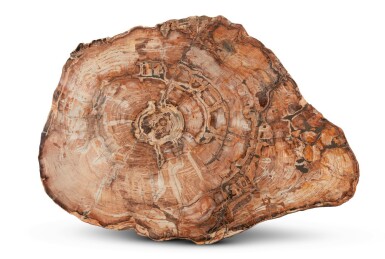
Property from the Russel-Zuhl Collection
A Giant Slice of a Petrified Golden Sequoia
Lot Closed
December 3, 07:34 PM GMT
Estimate
200,000 - 300,000 USD
Lot Details
Description
A Giant Slice of a Petrified Golden Sequoia
Sequoia affinis
Eocene (approx. 38 million years ago)
Madras Ranch, Clarno Formation, Oregon, United States
92 by 67 inches (233.7 cm x 170.2 cm). 83½ inches tall on custom stand with a footprint of 36 by 30¼ inches. 950 pounds (431 kg).
This section of an extinct Sequoia affinis was cut and polished to a mirror finish, exhibiting a range of colors from golds to ambers to tans to a smoky off-white. Its annual growth rings are clearly visible, documenting the story of this tree's life prior to its death and entombment in volcanic ash. It is impervious to stain and harder than granite or marble, with even the sharpest knife unable to damage its surface. Affixed to a 2 inch (5 cm) backing to assure stability and ease in mounting.
A true rarity. The petrified Sequoia affinis from which this large slice was cut, was entombed in volcanic ash 38 million years ago, long before being found in 2006 in the Clarno Formation of Central Oregon.
Petrified wood is the name given to a special type of fossilized remains of terrestrial vegetation. Over the course of thousands of years, inorganic materials in the groundwater surrounding this buried redwood conifer tree seeped in and replaced the organic minerals via a process known as permineralization. During this petrification process, the plant's lignin and cellulose decay, while inorganic materials essentially use the tree's organic structure as a scaffolding to build an exact rock copy of the specimen.
Currently, only one species of sequoia remains in existence, found exclusively in the coastal forests of Northern California and Southwestern Oregon. They the tallest trees in the world, with diameters reaching 30 feet (9 meters) and heights topping 250 feet (76 meters). They are also the heaviest—their biomass is equivalent to that of approx. ten blue whales, the largest animals to ever exist.
First appearing in the middle Jurassic, sequoias survived the extinction of the dinosaurs, but may not be able to survive the challenges of today's changing climate. Just last month, firefighters in Sequoia National Park wrapped the bases of trees in aluminum blankets to protect them against the ravages of the KNP Complex Fire. If these endangered redwoods can continue to stand the test of time remains to be seen, with the incredible specimen offered here acting as stirring reminder of the history, beauty, and fragility of life on planet Earth.
